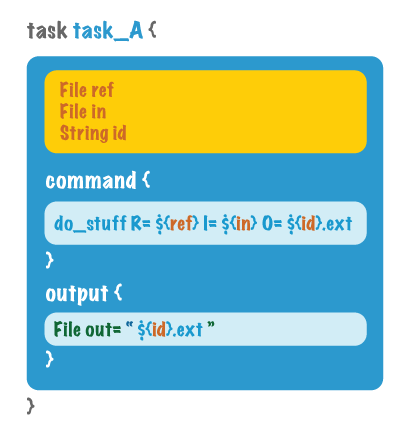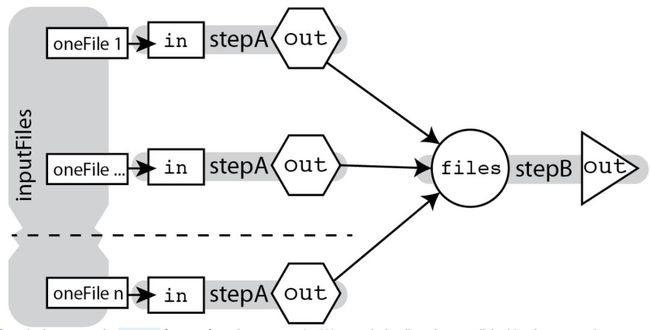欢迎关注"生信修炼手册"!
在GATK4的best practice中,不再像以前那样给出每个步骤对应的代码,而是直接给出了官方使用的pipeline。这些pipeline采用WDL进行编写。
WDL是一种流程编写语言,没有太多复杂的逻辑和语法,入门简单。首先看一个hello world的例子
workflow myWorkflow {
call myTask
}
task myTask {
command {
echo "hello world"
}
output {
String out = read_string(stdout())
}
}对于一个WDL脚本而言,有以下5个核心结构
workflow
task
call
command
-
output
每个脚本包含1个workflow, workflow由多个task构成。 在workflow中,通过call调用对应的task。每个task在workflow代码块之外单独定义。
task代表任务,读取输入文件,执行相应命令,然后输出。command中对应的就是执行的命令,比如一条具体的gatk的命令,output 指定task的输出值。可以将task理解为编程语言中的函数,每个函数读取输入的参数,执行代码,然后返回,command对应执行的具体代码,output对应返回值。
在WDL中,也是可以传递参数的。task和workflow中的写法不同
1. task 中的参数
下面的示意图中,task 有3个输入的参数,文件类型的ref,in 和字符串类型的id。 在command中,通过${ref}这种格式访问变量的值
2. workflow 中的参数
下面的示意图中, workflow 有3个参数,文件类型的my_ref,my_input 和字符串类型的name。传递这3个参数给task时,直接传变量名就可以了。
作为流程管理语言,需要对多个task统一管理。task之间具有多种关系
1. 一对一的依赖关系
前一个task的输出,作为后一个task的输入
workflow LinearChain {
File firstInput
call stepA { input: in=firstInput }
call stepB { input: in=stepA.out }
call stepC { input: in=stepB.out }
}
task stepA {
File in
command { programA I=${in} O=outputA.ext }
output { File out = "outputA.ext" }
}
task stepB {
File in
command { programB I=${in} O=outputB.ext }
output { File out = "outputB.ext" }
}
task stepC {
File in
command { programC I=${in} O=outputC.ext }
output { File out = "outputC.ext" }
}一个task的多个输出作为下一个task的输入
workflow MultiOutMultiIn {
File firstInput
call stepA { input: in=firstInput }
call stepB { input: in=stepA.out }
call stepC { input: in1=stepB.out1, in2=stepB.out2 }
}
task stepA {
File in
command { programA I=${in} O=outputA.ext }
output { File out = "outputA.ext" }
}
task stepB {
File in
command { programB I=${in} O1=outputB1.ext O2=outputB2.ext }
output {
File out1 = "outputB1.ext"
File out2 = "outputB2.ext" }
}
task stepC {
File in1
File in2
command { programB I1=${in1} I2=${in2} O=outputC.ext }
output { File out = "outputC.ext" }
}2. 多对多的依赖关系
一个task的输出作为多个task的输入,或者多个task的输出作为1个task的输入
示例如下:
workflow BranchAndMerge {
File firstInput
call stepA { input: in=firstInput }
call stepB { input: in=stepA.out }
call stepC { input: in=stepA.out }
call stepD { input: in1=stepC.out, in2=stepB.out }
}
task stepA {
File in
command { programA I=${in} O=outputA.ext }
output { File out = "outputA.ext" }
}
task stepB {
File in
command { programB I=${in} O=outputB.ext }
output { File out = "outputB.ext" }
}
task stepC {
File in
command { programC I=${in} O=outputC.ext }
output { File out = "outputC.ext" }
}
task stepD {
File in1
File in2
command { programD I1=${in1} I2=${in2} O=outputD.ext }
output { File out = "outputD.ext" }
}3. 平行关系
多个task之间完全平行,可以并行执行
示例如下:
workflow ScatterGather {
Array[File] inputFiles
scatter (oneFile in inputFiles) {
call stepA { input: in=oneFile }
}
call stepB { input: files=stepA.out }
}
task stepA {
File in
command { programA I=${in} O=outputA.ext }
output { File out = "outputA.ext" }
}
task stepB {
Array[File] files
command { programB I=${files} O=outputB.ext }
output { File out = "outputB.ext" }
}task和函数还是有一定的区别,函数可以在代码中多次调用,但是task多次调用会有风险。下面的示意图中,stepA 运行两次,一次作为stepB的输入,一次作为stepC的输入。如果stepA的两次调用并行执行,当执行完之后,在传递给下一个task时,由于存在两个同名的stepA, stepB和stepC 就会无法正确接受参数。
WDL中提供了解决方案,叫做task alias, 为task起一个别名,示例如下
workflow taskAlias {
File firstInput
File secondInput
call stepA as firstSample { input: in=firstInput }
call stepA as secondSample { input: in=secondInput }
call stepB { input: in=firstSample.out }
call stepC { input: in=secondSample.out }
}
task stepA {
File in
command { programA I=${in} O=outputA.ext }
output { File out = "outputA.ext" }
}
task stepB {
File in
command { programB I=${in} O=outputB.ext }
output { File out = "outputB.ext" }
}
task stepC {
File in
command { programC I=${in} O=outputC.ext }
output { File out = "outputC.ext" }
}在WDL脚本中, 理论上每个task 只可以调用1次,如果希望多次调用,必须借助task alias。
掌握以上几点,就可以理解一个wdl脚本的整体框架了。在实际使用中,我们只要能理解整个workflow的流向,会使用wdl脚本就可以了。
运行wdl脚本,需要两个文件
cromwell.jar
-
womtools.jar
最新版的下载链接如下:
https://github.com/broadinstitute/cromwell/releases/tag/31
第一步是得到输入参数的列表,用法如下
java -jar womtools.jar inputs myWorkflow.wdl > myWorkflow_inputs.json
用json格式存存储,这一步得到的只是一个模板,需要编辑这个文件,将对应的参数替换成实际的参数
第二步运行脚本,用法如下
java -jar Cromwell.jar run myWorkflow.wdl —inputs myWorkflow_inputs.json
总结
WDL是一种流程管理语言,语法简单,内置的支持并行等特征,适合编写pipeline。运行
wdl脚本只需两步,第一步编辑参数列表对应的json文件,第二步直接运行即可。
扫描关注微信号,更多精彩内容等着你!







